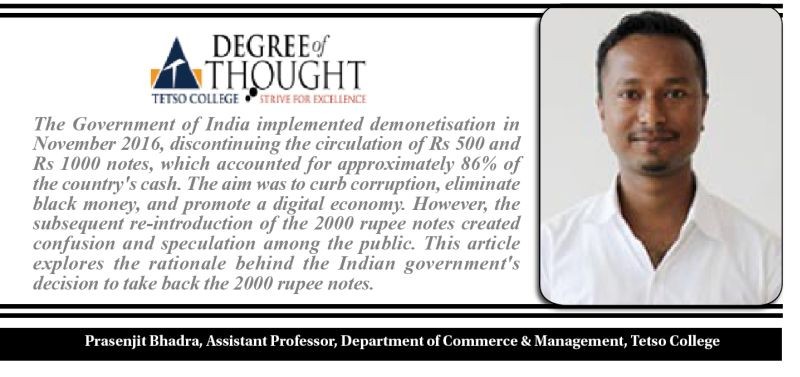
Demonetisation and its History: The demonetisation drive was launched with the primary objective of curbing corruption and eradicating black money. By withdrawing the high-value currency notes, the government aimed to unearth unaccounted wealth and disrupt illegal activities such as terrorism financing, counterfeit currency circulation, and tax evasion. The withdrawal of 500 and 1000 rupee notes was seen as a bold step toward achieving these goals.
Demonetisation refers to the process of stripping a currency unit of its status as legal tender. In India, there have been two major instances of demonetisation: one in 1946 and another in 2016. Here's an overview of the history of demonetisation in India:
1946 demonetisation: In 1946, the Indian government under British rule decided to demonetise the high-denomination banknotes in circulation, specifically the Rs 1000 and Rs 10,000 notes. The objective was to curb black money and reduce the fiscal deficit. The decision was met with mixed reactions, and many people faced difficulties exchanging their high-value notes for lower denominations.
2016 demonetisation: On November 8, 2016, Prime Minister Narendra Modi announced a sudden demonetisation of the Rs 500 and Rs 1000 banknotes, which accounted for around 86% of the total currency in circulation. The primary goal was to combat black money, corruption, counterfeit currency, and terrorism funding. The demonetisation process involved the withdrawal of the specified banknotes as legal tender and replacing them with newly designed Rs 500 and Rs 2,000 notes. The move was also seen as an effort to promote digital transactions and formalise the economy. The demonetisation announcement led to widespread confusion and chaos. People rushed to exchange their old notes for new ones, causing long queues outside banks and ATMs.
The sudden cash crunch disrupted daily life and had a significant impact on businesses, especially those relying on cash transactions in the informal sector. The Government of India implemented several measures to ease the situation, such as increasing cash supply, introducing new currency denominations, and promoting digital payments. However, the move faced criticism for its implementation, as the initial objective of curbing black money and counterfeit currency was not entirely achieved. The economy experienced short-term disruptions, with sectors like agriculture, small businesses, and informal labor being affected the most.
Despite the challenges, demonetisation also led to some positive outcomes. It helped increase the number of taxpayers, promoted digitisation, and brought unaccounted money into the formal banking system. The long-term effects and the overall success of demonetisation remain subjects of debate among economists and experts. It is important to note that demonetisation is a complex economic and political decision that can have wide-ranging implications. The specific motivations and outcomes can vary based on the context, implementation, and socio-economic factors of the country in question.
Introducing the 2000 Rupee Note: While demonetising the higher denomination notes, the government also introduced the 2000 rupee note as a measure to bridge the gap in liquidity caused by the sudden withdrawal of cash from circulation. The introduction aimed to facilitate transactions and maintain the cash flow in the economy during the transition period. It was intended to be a temporary measure until the new 500 rupee notes were widely available.
Challenges faced: The reintroduction of the 2000 rupee notes was met with mixed reactions from the public. Some perceived it as contradictory to the government's objective. Critics argued that the high denomination note would once again make it easier for illicit cash transactions. Additionally, the larger denomination also posed challenges for small traders and rural communities, as they faced difficulties in providing change for the 2000 rupee note.
The Phasing Out Process
Over time, the government realised the challenges posed by the Rs 2000 note and took steps to phase it out gradually. This was done by reducing its circulation and replacing it with smaller denomination notes. The government encouraged the use of digital payment systems to promote a cashless economy and reduce the reliance on high-value currency notes. By gradually reducing the availability of Rs 2000 notes, the government aimed to address the concerns raised and transition to a more manageable currency system.
Impact on Counterfeit Currency: One of the key benefits of demonetisation was the significant blow it dealt to counterfeit currency networks. With the introduction of new currency notes, enhanced security features were incorporated, making it harder to produce fake currency. By withdrawing the 2000 rupee note, which was the highest denomination in circulation, the government aimed to make it even more challenging for counterfeiters to replicate. This move played a crucial role in curbing the circulation of fake currency.
Moving Towards Digital Payments: The demonetisation drive served as a catalyst for the adoption of digital payment systems in India. With the reduced availability of cash, people were compelled to explore alternative modes of transactions, such as mobile wallets, UPI (Unified Payments Interface), and digital banking. The government's focus on promoting digital payments aligned with its vision of creating a transparent and efficient economy. The transition from cash-based transactions to digital payments aimed to curb corruption, increase tax compliance, and enhance financial inclusion.
The Indian government's decision to withdraw the 2000 rupee notes was a calculated move aimed at achieving the objectives of demonetisation. Although the reintroduction of the high denomination note initially raised concerns, the government took steps to phase it out gradually, addressing the challenges and transitioning towards a more manageable currency system. The move also played a significant role in curbing counterfeit currency networks and promoting the adoption of digital payments, aligning with the government's vision of a transparent and digitally-driven economy. While the demonetisation drive had its share of challenges, it was a bold step that demonstrated the government's commitment to combating corruption and promoting financial reforms in India.
The Degree of Thought Column is a weekly community column initiated by Tetso College in partnership with The Morung Express. The column explored contemporary social, cultural, political, and educational issues and challenges around us. However, the views expressed here do not reflect the opinion of the institution. Tetso College is a NAAC-accredited, UCG-recognized Commerce and Arts college. Currently, the Degree of Thought Column is managed by the department of Mass Communication, and the editorial team are Dr Jenny Lalmuanpuii, KC Gabriela and Rinsit Sareo. For feedback or comments, please email:dot@tetsocollege.org.






